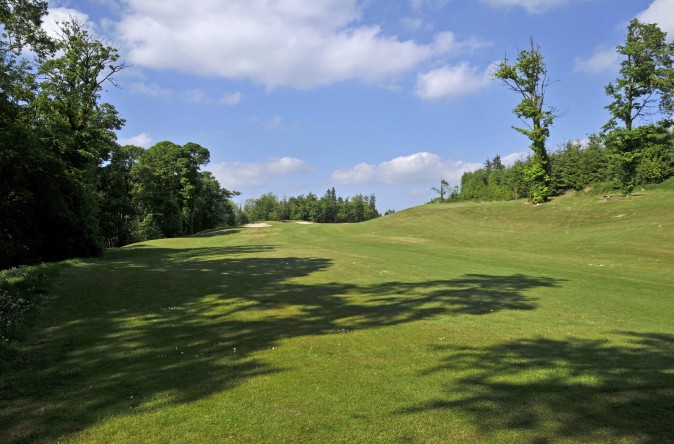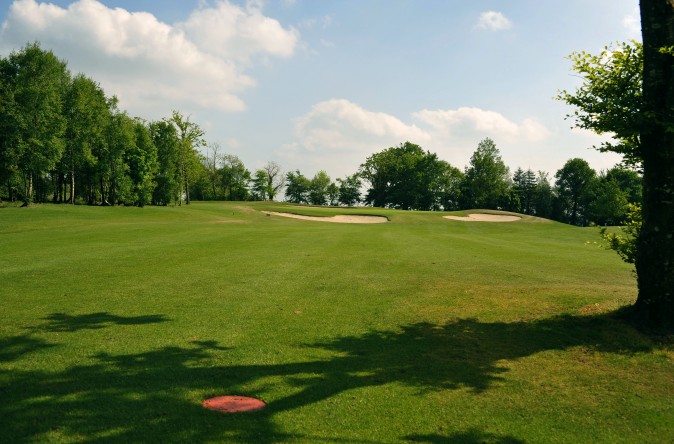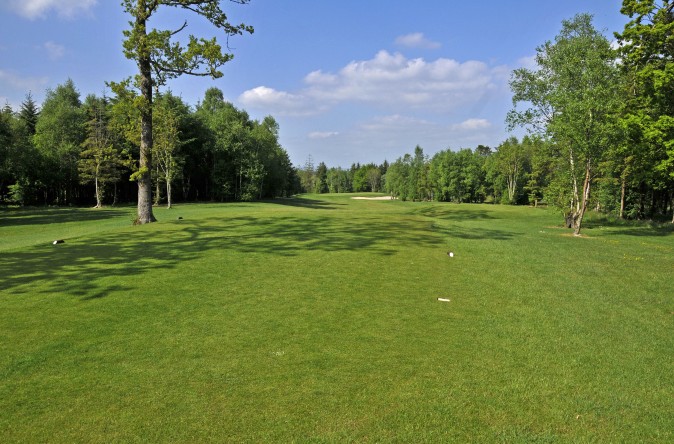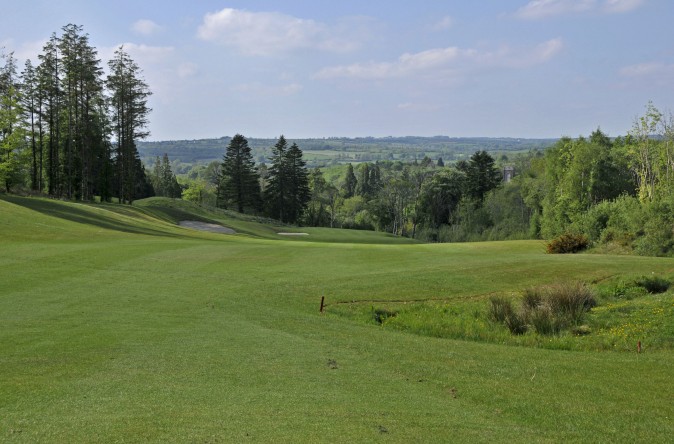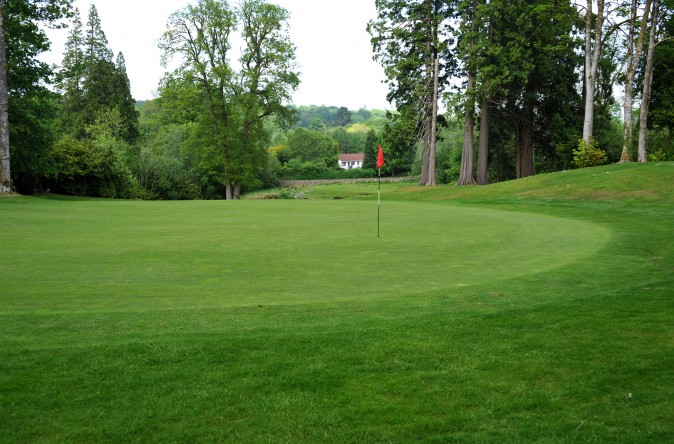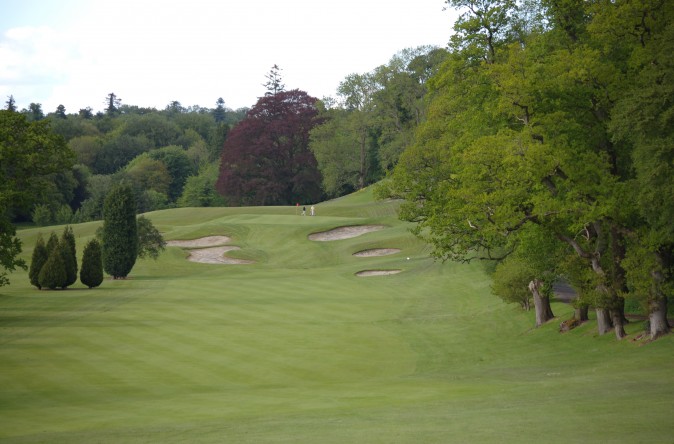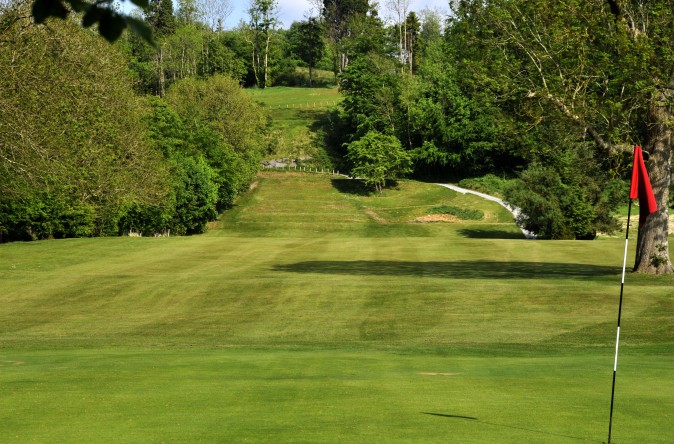Our Course
Scorecard
View our course scorecard here
Hole by Hole Guide
Hole 1 - Sawney's Wood
A difficult drive played through trees with bunker on left hand side of fairway to be avoided. The second shot is played to the right hand side of the fairway leaving the best approach to the elevated green well protected by bunkers. When at the green look behind you for a spectacular view.
Sawney’s Wood so called on account of it being the residence of Sawney Bradley Forester and the first of the family to come to this country having been brought over by Sir Christopher Wandesforde in 1636.
Hole 2 - Drumgoole
A dogleg left with a bunker on the right at turning point and two trees between bunker and wood on left. The ideal tee shot is left of the trees on fairway. The second shot places a premium on distance judgement. Anything short faces sand and long possibly out of bounds. Enjoy the view.
The golf course span 2 towns lands, Drumgoole and Smithstown. Drumgoole being the Irish for a hill of coal is the location of the clubhouse and comprises 90% of the golf course.
/p>
Hole 3 - The Birches
A long but beautiful par 3 played from an elevated tee demanding a solid tee shot to a shallow green protected by a bunker at front and an unseen one at rear. The green rises from the left to right and demands an experienced eye to read its subtleties.
As an appreciation of the magnificent variety of trees on the golf course this hole was so named because of the copper and silver birch lining the fairway. The great diversity of trees to be found includes 8 varieties of Oak, the rarest been an English Oak and the only one to be found in the locality, American Redwood, Cedar, Ash the rarest being African.
Hole 4 - Van Diemens
The most difficult par 4 on the course. A long accurate tee shot is needed to reach the fairway bunker. Only the longest hitters will attempt to thread the ball between the bunker and trees on the left. The second shot is very demanding as the out of bounds on the right and bunker short of the green with a swale behind it demand length and accuracy. A bogey here is never refused.
Located in the adjoining towns land of Donaguile. Due to the demolition of the house in Pitcher Street, a family was relocated to this area and they left it so keenly at being sent out of the town that they styled it Van Diemen’s it being for them the equivalent of a transportation order.
Hole 5 - Ruddy's
The touch of a master can be seen in the design of this hole. The gently rolling fairway surrounded by woodland of evergreens and birch, to the location and shape of the green amongst the large oaks and spruce help to make this the consummate golf hole offering the golfer many challenges.
Pats favourite. Our original 9 holes was his first design and he has since become internationally renowned, being the only Irish Golf Architect to design courses on the North American Continent. Three of his courses are listed in the top 100 in Britain and Ireland including his own course, the magnificent European Club. His contribution to Irish Golf was recently recognised when he received an award presented by the Irish Sports “Writers” Association.
Hole 6 - Spa Well
A spectacular par 5 played from a tee amongst large pines. The tee shot requires courage, accuracy and good distance judgement to leave one in the ideal position to avoid the stream unseen from the tee. From here the second shot must be equally accurate to avoid the water running the length of the hole on the right. The green is narrow and well protected by sand and demands a very good third shot.
Named after an ancient well located at the exit from 6th green. The bridge at the 7th tee was constructed to provide access from Castlecomer House to the well. The water from this well is reputed to cure all golfing ailments.
Hole 7 - An Droichead
A short pretty par 4 requires a tee shot of some 160 metres. As there is out of bounds on the right. The green with no bunkers for protection is protected by the sever slope from back to front right. A high soft second shot gives the best chance of par.
The bridge was originally constructed to provide access from the blue gate via the Majors walk to the estate. Renovated during the construction of the course this bridge has changed direction at least 3 times in its history and is now back to its original design. The stone used in its renovation came from the ruin of Castlecomer House.
Hole 8 -Deer Park
A short spectacular par 4 played from a tee between two rock cliffs. A slight draw from the tee will leave a short second shot to a green protected by sand. Don’t be long with the second shot as the ground at rear of green slopes severely away. The key here is distance judgement.
Castlecomer is renowned for coal mining with a history spanning over 300 years. Deerpark the largest of the mines and during the troubled war years, over 700 men and boys worked underground and produced what was regarded as the best anthracite in Europe.
Hole 9 - Abyssinia
The shortest of the 18 holes but one of the most beautiful and spectacular par 3’s in golf. The tee shot uphill must be threaded between the rare English Oak on the right and the giant cedars on the left, to a green sloping back to front. Anything short will be swallowed up by the deep bunker at the front. Judging the wind is not easy and adds a further difficulty to this short hole.
The coincidence that this hole is a par 3 played through a tree lined fairway is amazing as it is a replica of the 7th hole on our original course in Clashduff. A war in Abyssinia now known as Ethiopia coincided with the founding of our club in 1935 and this name became famous with golfers throughout Ireland. In modern day parlance it was the signature hole of that course. Many a battle was fought for par.
Hole 10 - Cloudmount
Don’t let the view from this high tee distract you as the drive must be hit straight to avoid the trees left and right. The drive safely negotiated the second shot to a well protected small elevated green requires accuracy and good distance judgement.
Castlecomer Golf Club founded in 1935 was originally located on land owned by the Holmes family at Cloudmount, Clashduff. The copse of trees on the brow of the hill viewed from the 8th tee was the location of this course.
Hole 11 - Millenium
The second longest par 4 requires a long accurate tee shot if par is to be assured. The second shot to a well protected elevated green may require your longest club. A par here puts you in good spirits for the back 9 and will certainly be recounted at the 19 hole.
Named after the Millenium Stone adjacent to putting green.
Hole 12 - Windy Gap
A long par 5 requires a fade from the tee around the corner of the wood. The second shot must find the fairway if the third shot is to find the elevated green protected by 5 large bunkers. Beware of the bunker on left of green unseen from the fairway.
Known to workers on the estate as the windy gap which refers to the gap between the estate lawns and the estate farm now the location of the 10th tee, car park and clubhouse.
Hole 13 - Wandesfordes
A beautiful par 4 played from a tee high above the fairway. Those fond of taking risk may try to drive the green. However with out of bounds right and the beech tree in centre of fairway the risk may not be worth the possible reward. Conservative play should leave a birdie putt.
Called after the Wandesforde Family who came from Yorkshire in 1636. The course comprises 158 acres of the estate lawns and woodland. The family home Castlecomer House constructed in the early 1800’s was the third and final Wandesforde residence to be built on this site. This magnificent house was one of the finest examples of 18th Century architecture, its splendour indicated by its 365 windows.
Hole 14 - The Convent
A difficult par 4 with trees left and right The Deen River runs the length of the hole on the right The key to this hole is the tee shot which must be long and straight if the elevated green is to found with the second shot The bail out left leaves a difficult pitch and run from amongst the large trees.
Named after the Presentation Convent to right of this fairway; the sisters came to Castlecomer in 1829 and built a convent on this site in 1877. Up to the famine years had 500 children attending daily.
Hole 15 - The Silvery Deen
Don’t be fooled by what looks like a straight forward hole. The three bunkers avoided by the tee shot leave a putt on the green which slopes severely from back to front. Anything above the pin leaves a treacherous putt and a difficult 2 putt.
The Deen River flows behind this tee box. The Castlecomer song The Silvery Deen was composed by James Fogarty in the 1880’s. “That sweetest dearest place of mine, that changeless charming scene„ is by the banks where fairies play, down by the silvery deen”.
Hole 16 - Alsinore
The last long par 4. Premium here is a long accurate tee shot between the wood on right and the tree in the fairway at landing distance. The green sloping front to back and right to left requires an experienced eye if a par is to be found. Try not to be distracted by the squirrels when playing this hole.
The town of Castlecomer with its distinctive charm is located in the centre of the territory of the Old Irish family- The Brennans. In 1635 the town and Brennan lands were handed over to Sir Christopher Wandesforde who proceeded to lay out an elegant town, apparently modelled on the picturesque Italian town of Alsinore.
Hole 17 - The Garrison
The last par 3 played up hill to a green located within the wood. The prevailing wind into the player changes the clubbing dramatically on this hole. The green difficult to read does not yield many birdies. Enjoy the evening bird song when on this green as you are nearly home.
Castlecomer was so called from its proximity to an ancient castle which stood on a mound known as the Garrison. The stone from this castle was used in construction of Castlecomer House in the early 1800’s
Hole 18 - The Laundry
The Shortes par 5, a good birdie opportunity. A good drive down the right hand side of fairway avoiding bunker on left will leave the green reachale with second shot. The green is shallow, slopes back to front and is protected by sand front and back. A shot from the bunker at back may result in the next shot being from the bunker in front. a birdie here makes the 19th hole more enjoyable.
Situated on the right of the 18th fairway is the Laundry, presently the home of the Smith Family which was originally the laundry for the estate.

